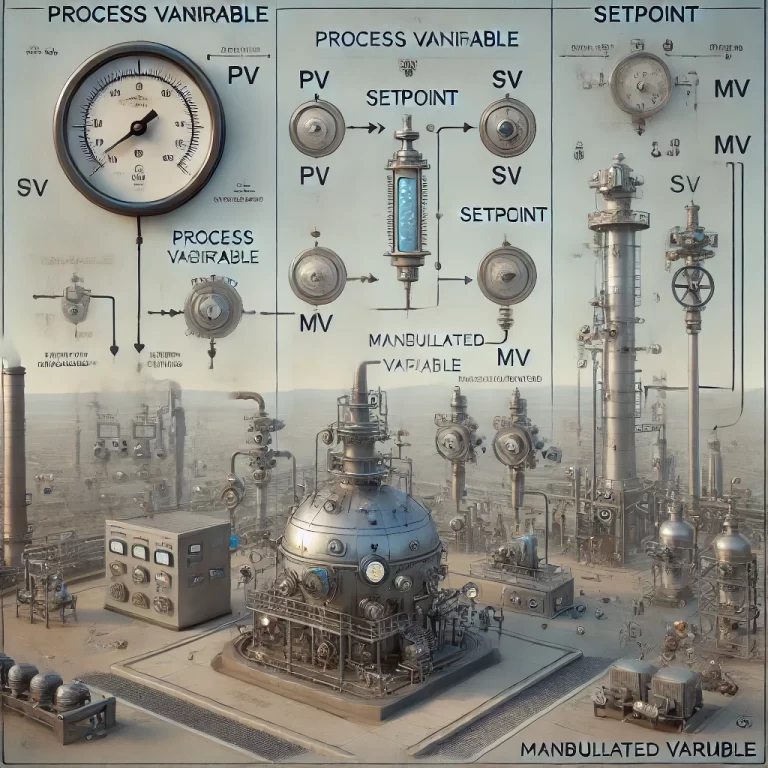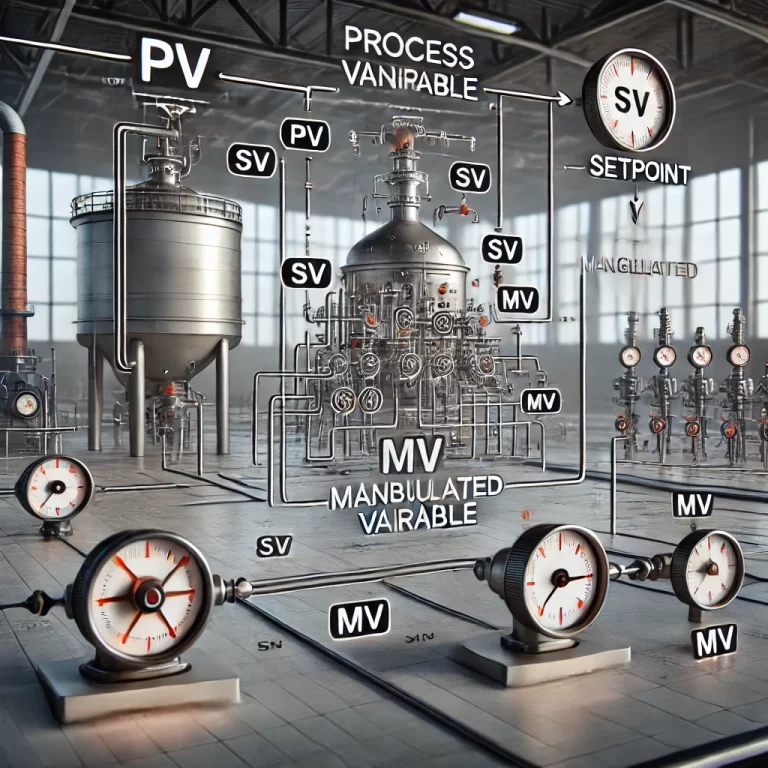In industrial control systems, three critical parameters — PV (Process Variable), SV (Setpoint), and MV (Manipulated Variable) — play an essential role in ensuring the stability and efficiency of production processes. Understanding the relationship between these three parameters is at the heart of modern industrial automation. This article aims to provide a clear and detailed explanation of PV, SV, and MV, using simple examples to illustrate how they work together in industrial applications.
What Are PV, SV, and MV?
PV (Process Variable):
The process variable (PV) is a real-time measurement of a parameter in the production process. It represents the current state of the system, such as temperature, pressure, or flow rate. For example, the temperature in a reactor vessel or the pressure in a pipeline can be measured as PV. Simply put, PV is the data you can “see with your own eyes” — it shows the current status of the equipment and system.
Since industrial processes are dynamic, the PV will constantly change. Equipment operates under different conditions at various times, meaning that the process variable can fluctuate. Accurate PV data allows the control system to evaluate whether the process is operating as expected and if adjustments are needed.
SV (Setpoint):
The setpoint (SV) is the target or desired value for a process variable. It is determined based on the process requirements or product quality standards. For example, in a chemical reaction process, the engineer might set the desired temperature of the reactor at 100°C. This 100°C is the SV, representing the ideal or target state of the system.
In many industrial processes, the setpoint is not fixed but can be adjusted according to external conditions or changes in the process. For instance, in polyethylene production, the SV may change dynamically depending on factors such as reaction conditions and raw material quality.

MV (Manipulated Variable):
The manipulated variable (MV) is the variable that the control system uses to adjust the process in order to bring the PV closer to the SV. It is the actual control action applied to the system, such as adjusting the heating power, valve opening, or pump speed.
For example, if the PV is lower than the SV, the control system might increase the heating steam flow to raise the temperature of the reactor. Conversely, if the PV is too high, the system might reduce the heating or decrease the flow to bring the temperature back to the desired level. MVs are the actions that allow the system to stabilize and correct deviations between PV and SV.
How Do PV, SV, and MV Work Together?
The interaction between PV, SV, and MV is fundamentally a feedback loop. Here’s how it works:
- SV as the Target: The SV defines the ideal or target operating state of the process. For example, the setpoint could be a temperature of 100°C, representing the desired state.
- Real-Time Feedback from PV: The control system continuously measures the PV to compare it with the SV. Any deviation between the PV and SV indicates that an adjustment is needed.
- Adjustment through MV: The system then calculates the appropriate MV — the corrective action needed — to bring the PV closer to the SV.
The loop continues dynamically, making continuous adjustments until the system reaches a stable state where the PV is as close to the SV as possible.
Example: Temperature Control in a Reactor
To illustrate the interaction of PV, SV, and MV, let’s look at an example of temperature control in a reactor:
Initial State:
- The desired temperature (SV) is set to 100°C.
- The current temperature (PV) is measured at 80°C.
- The control system needs to increase the temperature, so it adjusts the manipulated variable (MV), which in this case is the steam valve opening.
Adjustment Process:
- The control system detects that the PV is lower than the SV, indicating the temperature is too low.
- The system responds by increasing the steam flow (adjusting the MV) to heat the reactor and raise the temperature.
Stabilization:
- As the temperature rises, the PV approaches the SV (100°C).
- When the temperature reaches the target, the system reduces the steam flow, stabilizing the temperature at 100°C.
- The MV also stabilizes, keeping the temperature constant.
This continuous adjustment ensures that the system remains at the desired operating point, maintaining stability in the production process.

How Do Engineers Use These Parameters?
In industrial control, engineers are responsible for monitoring and adjusting these parameters to ensure the system runs safely and efficiently. Here’s how they interact with each parameter:
- SV (Setpoint): Engineers determine the appropriate setpoint based on the production requirements or product specifications. For example, in a batch process, the setpoint for temperature, pressure, or flow will be set to achieve the desired reaction rate and product quality.
- PV (Process Variable): Engineers ensure the accuracy of the process variable measurements by regularly calibrating sensors and maintaining equipment. Accurate PV data is critical for ensuring the process is operating as expected.
- MV (Manipulated Variable): Engineers set the control system to respond appropriately to any deviation between the PV and SV. Based on the difference between these two values, the system adjusts the manipulated variable to bring the process back into the desired state.
Additionally, engineers must account for various factors like sensor calibration, system delays, and actuator performance to ensure optimal control.
Conclusion
PV, SV, and MV are the three pillars of industrial control systems. They work together to maintain the efficient and stable operation of processes. PV provides real-time feedback, SV sets the ideal target, and MV is the control action used to correct deviations and bring the process into alignment with the target. Understanding the relationships between these parameters is essential for improving production efficiency, ensuring product quality, and maintaining the safety of industrial systems. By mastering these control principles, engineers can optimize industrial processes and ensure systems remain stable even in dynamic and fluctuating conditions.
